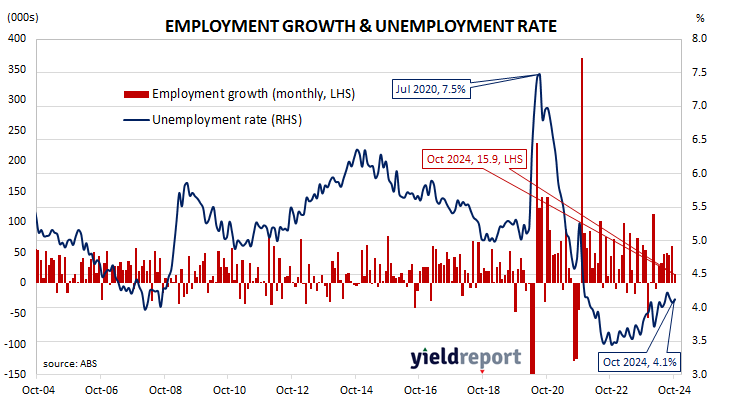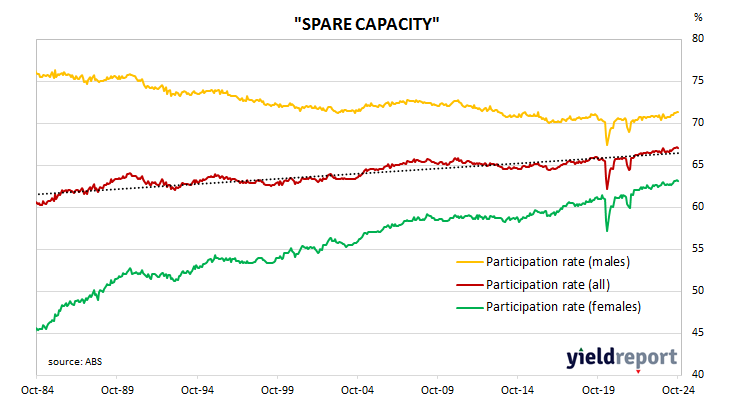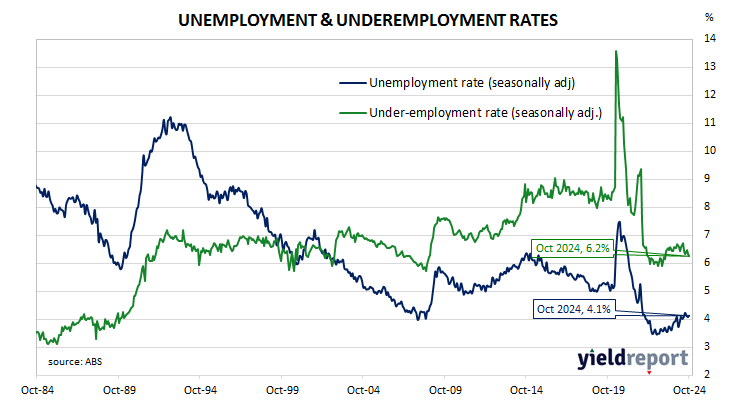Summary: Employment up 15,900 in October, less than expected; Westpac: job market in relatively solid health, becoming more balanced; short-term ACGB yields slip, longer-term yields rise; rate-cut expectations soften, Feb cut unlikely; Citigroup: labour market remains tight; participation rate declines to 67.1%; jobless rate steady at 4.1%; more part-time jobs, full-time jobs; aggregate work hours up 0.1%; underemployment rate falls to 6.2%.
Australia’s period of falling unemployment came to an end in early 2019 when the jobless rate hit a low of 4.9%. It then averaged around 5.2% through to March 2020, bouncing around in a range from 5.1% to 5.3%. Leading indicators such as ANZ-Indeed’s Job Ads survey and NAB’s capacity utilisation estimate suggested the unemployment rate would rise in the June 2020 quarter and it did so, sharply. The jobless rate peaked in July 2020 but fell below 7% a month later and then trended lower through 2021 and 2022.
The latest Labour force figures have now been released and they indicate the number of people employed in Australia according to ABS definitions increased by 15,900 in October. The result was less than the 25,000 rise which had been generally expected as well as September’s downwardly-revised increase of 61,300.
“Today’s data is a reminder that the Australian labour market remains in relatively solid health and is gradually becoming more balanced,” said Westpac economist Ryan Wells.
Short-term Commonwealth Government bond yields slipped on the day while longer-term yields increased moderately. By the close of business, the 3-year ACGB yield had lost 1bp to 4.21%, the 10-year gained 3bps to 4.71% while the 20-year yield finished 4bps higher at 5.01%.
Expectations regarding rate cuts in the next twelve months softened, with a February cut now viewed as unlikely. Cash futures contracts implied an average of 4.325% in December and 4.295% in February 2025. October 2025 contracts implied 4.015%, 32bps less than the current cash rate.
“The labour market remains tight and the unemployment rate was unchanged at 4.1%,” said Citigroup economist Faraz Syed. “That said, employment growth was weaker than expected, and the labour force participation rate was down. Other measures of labour market health improved, including the number of hours worked and underemployment.”
The participation rate slipped from September’s series-high of 67.2% to 67.1% as the total available workforce increased by 24,200 to 15.163 million. The number of unemployed persons increased by 8,300 to 625,800 but the unemployment rate remained steady at 4.1% after rounding and revisions.
The aggregate number of hours worked across the economy increased by 0.1% as 6,200 residents gained part-time positions and 9,700 residents gained full-time positions. On a 12-month basis and after revisions, aggregate hours worked increased by 2.5% as 150,000 more people held part-time positions and 237,100 more people held full-time positions than in October 2023.
More attention has been paid to the underemployment rate in recent years, which is the number of people in work but who wish to work more hours than they do currently. October’s underemployment rate declined from 6.3% to 6.2%, 0.3 percentage points above this cycle’s low.
The underutilisation rate, that is the sum of the underemployment rate and the unemployment rate, has a strong correlation with the annual growth rate of the ABS private sector wage index when advanced by two quarters. October’s underutilisation rate of 10.4%* corresponds with an annual growth rate of about 4.0%.
* difference due to rounding




